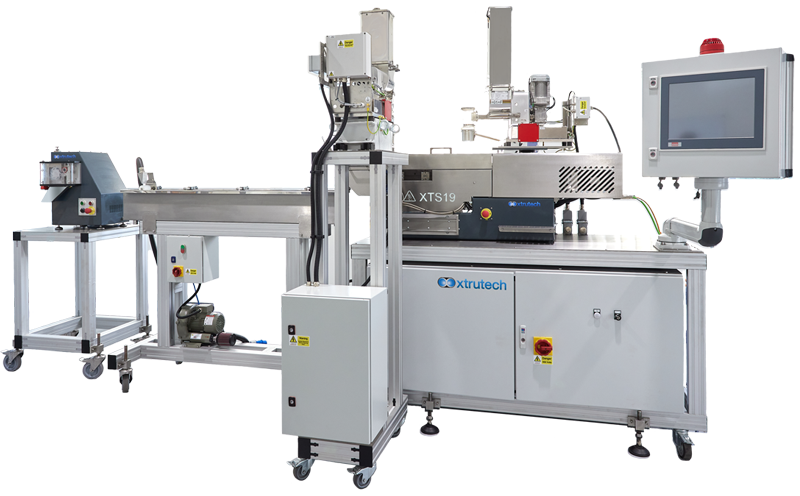Plastic extrusion has revolutionised the creation of plastic products due to its precision and convenience. The process supports the development of new formulations through masterbatch and compounding, that are used in applications such as injection and blow moulding. Objects with continuous profiles like pipes, tubes and wire insulation are also suitable applications.
- Plastic Extrusion Process
Plastic extrusion can be illustrated as a process where suitable raw materials are fed into a barrel and mixed whilst controlled through heating and cooling. This process produces an homogenous melt. The uniformed melt is then fed through a die to create the desired shape. Often cooled in a water bath and pelletised.
Xtrutech offers a complete extrusion production line, which includes an extruder, pelletiser, feeder, and water bath. We can provide laboratory-scale extruders for plastic extrusion, including the XTS11, XTS19, and XTS24. We also offer a variety of high-speed mixers, ancillaries, services, and replacement parts. Our extruders are made from quality materials and are easy to use and maintain.
- Plastic Extrusion Benefits
Our extruders not only boast high efficiency and productivity but they are also designed for reduced maintenance and simplified cleaning. They feature a convenient clamshell barrel that allows easy access for the removal, cleaning, or replacement of screws and shafts. The barrel is equipped with insert liners, providing both easier maintenance and cost-effective replacement options when necessary. Other benefits include the following:
- Coextrusion: Several layers of plastic material can be extruded at the same time. The process involves two or more extruders that feed different materials into one extrusion head.
- Inherent versatility: Plastic extrusion produces various products with varying thicknesses, colours, textures, and designs. Manufacturers can also include additives to change the properties of a product and make it more durable.
- Minimal waste production: Plastic extrusion produces very little waste due to its ability to create precise custom shapes, maximising material usage and requiring little to no trimming.
- Excellent material compounding: Plastic extrusion excels in material compounding due to its capacity for homogeneous mixing, controlled processing conditions, and flexibility in incorporating a wide range of additives and components.
- Wide range of raw materials: The technique accepts a variety of thermoplastic materials both ductile and brittle. The extensive material selection enables manufacturers to make products with varying properties like flexibility, strength, heat resistance, and chemical durability.
- High-quality surface finish: Plastic extrusion produces parts and components with a high level of polishing or texture for an aesthetic look.
- Economical: Plastic extrusion is a continuous operation that efficiently generates products in high volumes. It is an efficient choice for bulk manufacturing when addressing substantial demand.
- Plastic Extrusion Applications
Common applications for extruded plastic include:
- Injection and Blow Moulding: Plastic pellets are produced and supplied to produce moulded components.
- Pipes and tubes: Plastic piping and tubing are typically made from polyvinyl chloride or thermoplastics and are common extruded plastic parts since they have a simple cylindrical profile.
- Wire insulation: Plastics have electrical insulation properties and are commonly used for cable and wire jacketing to provide safety and organisation. Extruded wire insulation uses fluoropolymers due to their non-adhesive, chemical, and weather-resistance properties.
- Thermoplastic coatings: A thermoplastic coating is a medium-density plastic applied to metal objects as a decorative or protective coating. Plastic extruded coatings have excellent weatherability and are effective in harsh environments.
Extrusion Services From Xtrutech
When selecting extrusion equipment, it is essential to consider factors such as design, output requirements, material feedstock, additives, pigments, feeding, temperatures etc. For a quality total solution, please discuss with the experienced Xtrutech team.
With our advanced machinery, you can deliver extrusion services with better quality, reliability, and cost-effectiveness. Contact us today to learn more.
